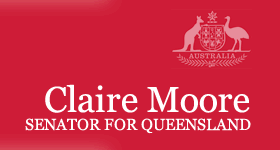Last Saturday afternoon I jumped out of the plane-and I can assure you, Madam Acting Deputy President, I was very securely attached to Gus from Argentina, who managed to tell me at the time that, while it was my first jump, he had made over 7,500. The reason I was there-there must have been a reason!-was a visit I had last year from a young man, Josh Burton, and his mate, Sam Lamprecht, who both have juvenile or type 1 diabetes. They had come to see me with their mums because they are part of a wonderful scheme, auspiced under the Juvenile Diabetes Research Foundation, for young people to talk with their local parliamentarians about what it is like to live with diabetes, what they have to do and, most importantly, what they want their government to do to take on the responsibility as government to look after people in the community. We have had several meetings since that time, but in that first meeting Josh said, just as a throwaway line: 'Have you ever jumped out of the plane?' I could say with absolute honesty that the answer was no.
Josh then went on to tell me about the program they have called Jump for a Cure, which has been going for several years. It encourages people to get together with wonderful local providers, in our case it was the Ramblers Club on Queensland's Sunshine Coast, who work with people to give them the excitement and enjoyment of skydiving-if you do find it that way, and luckily I did. The team work to raise awareness of this condition in our community but, more importantly, there is hope and encouragement that we can find a cure. Each year it raises significant funds, and I am really proud that the Queensland jump at the Sunshine Coast last Saturday raised over $80,000. I congratulate the 50-odd people-and that means numbers, not type, of people-who gathered together to jump, to say that we wanted to work on this issue.
The youth advocates scheme has enabled so many people in this place to meet young people over many years through the fantastic Kids in the House program. Former Senator Barnett has been a driving force in raising awareness of this issue in this place and in the wider community. There is not a parliamentarian who has not had the opportunity to meet the amazing young people who come here and also their parents, because so much does rely on families and friends to work through this process. Through the Kids in the House program we get a chance to be visited by young people; they talk with us and share their experiences. As I said in relation to Josh and Sam, they can look us in the eye and say what is needed in our parliament and in our community to make sure that cure can be found.
Have no doubt, these young people know that a cure can be found and they expect us to work with them to find it. They are able to tell us about the process that has happened with the money that has been raised over the years to ensure that there is an effective research program in this country. As always when we have these schemes, we see the amazing work which Australian researchers have done. They are internationally regarded, they have made advances and it is exciting. The Clinical Research Network, the CRN, is a cutting-edge program giving Australians the chance to look at new therapies and treatments. It is based on cooperation, which is a core element. We have people working across the country in various institutions who have skill and ability which they need to share and, as we always see, collaboration is the best form of work. This collaboration is between researchers, institutions, patients, industry and international networks. The CRN was originally established in 2010 with a grant of about $5 million, but it needs to be continually funded so that more work can be done and more can be achieved.
Three clinical initiatives have already been funded by the CRN which are important and make a difference. One initiative is exploring hypoglycaemia prevention. Researchers in hospitals around the country are looking at how glucose sensors attached to an insulin pump can predict life-threatening low blood sugar levels. The amazing work of those pumps has made such a difference to people of all ages who have diabetes. It gives them the discipline and security that their process will be looked at and they will get those messages through. There is also a project which examines the use of an old drug in a new way to tackle type 1 diabetes complications, including heart attacks and strokes, through the REMOVAL Australian substudy. This is part of a multisite international trial contributing to international best practice. So we are part of the international work that is gathered this research together so that we can share the knowledge and work towards a cure.
The third initiative is a focus on patient driven research through the Australian Diabetes Data Network that aims to embed the latest research and data in health care delivery so that patients are better able to inform research. We know that data on every patient with type 1 diabetes could be collected in one place and could then be used for future research. We heard earlier from Senator Xenophon about the amazing aspect of having that data together. Certainly there is so much discussion in the industry at the moment about how we can have that central gathering of information which can then be used as a basis on which we can build.
We need to maintain this funding. There will be processes put to government to ensure that more funding is available so that we can continue the work that has begun. We do not want to waste or lose any of the research data we have already gathered, so the funding must continue. I am sure the arguments for that will continue in this place. I do not think anyone can look at those young people who come to see us and say that we will not respond. It is a very valuable and effective mechanism for advocacy.
We also need to acknowledge in this place the work of the Friends of Diabetes, which was formed several years ago and was one of the first friends groups. My friends Judi Moylan and Mal Washer, who are both leaving us at the next election, assure me that it was the first friends group-and who am I to argue. Their work over many years has ensured that we have the ability to bring together people to share their knowledge and I think the work of that friends group will continue. Our new convener is Ken Wyatt from Western Australia. Only last week, when we had a gathering here to look at a whole range of issues around diabetes, we were able to have a function to acknowledge the work of Judi and Mal and to welcome Ken into the new position. There is a great legacy there that I know that he will follow. We will continue as always to have the ability in this place to get the best possible information and the best possible visitors to come and tell us about the best and most up-to-date models of practice and also the activities that we can do together to ensure that we can respond to the issues of diabetes in our community.
Next year we will go back and we will go into a larger team to jump for a cure again. Already I am taking signatures of people who would like to share this experience both here and interstate. There is an opportunity here for people to do something different and also, through that difference, to raise money and awareness for an important cause. I want to thank Josh in particular, who had the faith that I would be able to do it and who gave me an opportunity that I think I have always really wanted, which was to have a parachute jump. Next year I hope to be back in this place again to acknowledge that we can make a difference and that this is an area where we can truly achieve a cure for diabetes.




